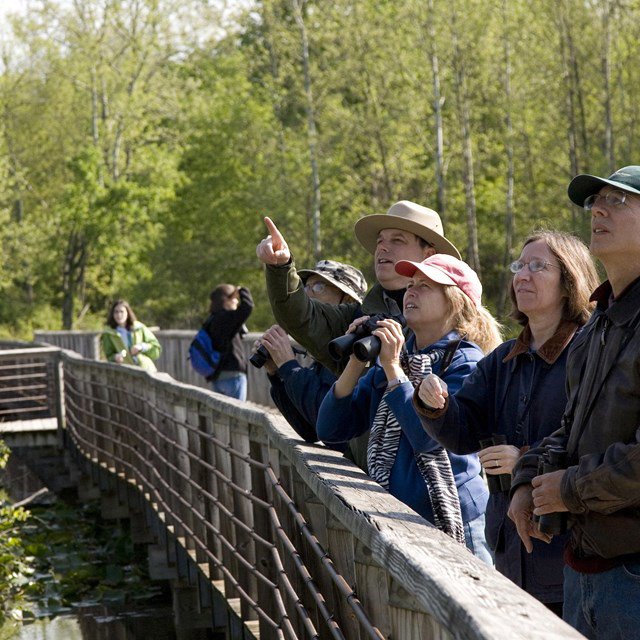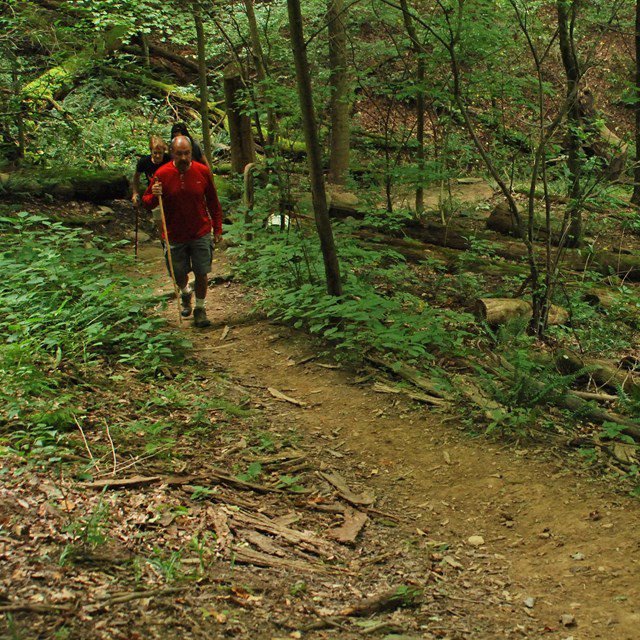Lyceum Series: Celebrating 50 years of the Cuyahoga Valley National Park
The Cuyahoga Valley National Park marks its 50th birthday this year. The process of creating and preserving a park in an urban area was long and complex and took the work of the entire community.
It all started in 1940 when the Cuyahoga Valley Association was formed to “restore, preserve and develop the natural resources of the Cuyahoga Valley and the territory of its watershed for the benefit of all the people.” But plans to create and preserve natural areas in the region date back to the 1920s and 1930s, with efforts to create the Cleveland Metroparks and Summit Metro Parks.
On December 27, 1974, the U.S. Congress officially designated 22,000 acres along 22 miles of the Cuyahoga River in Cuyahoga and Summit counties as the Cuyahoga Valley National Recreation Area (CVNA).
 Cleveland Metroparks opens the first 2.5-mile section of trail along the towpath in Brecksville, 1975.The measure, sponsored by U.S. Representative John F. Seiberling and signed by President Gerald Ford, established the area to preserve the “scenic, recreational, natural, and historic values” of undeveloped land between Cleveland and Akron, land threatened by commercial development and rapid population growth. The CVNA was officially established as the third urban park in the National Park System in June 1975. In 2000, it was re-designated as a National Park.
Cleveland Metroparks opens the first 2.5-mile section of trail along the towpath in Brecksville, 1975.The measure, sponsored by U.S. Representative John F. Seiberling and signed by President Gerald Ford, established the area to preserve the “scenic, recreational, natural, and historic values” of undeveloped land between Cleveland and Akron, land threatened by commercial development and rapid population growth. The CVNA was officially established as the third urban park in the National Park System in June 1975. In 2000, it was re-designated as a National Park.
While June 2025 marks the park’s actual 50th anniversary, park officials, the Conservancy for CVNP, community partners, park lovers, and supporters kicked off the celebration this past September. The events will continue throughout the year.
Park officials invite everyone to celebrate with them, and there is something for everyone—from exploring 50 Ways to Experience Cuyahoga Valley National Park to Environmental Educational opportunities for all ages to reading about how the park got its start more than a half-century ago.
True to its motto “protecting today, preserving tomorrow,” the Conservancy’s mission is to enrich people’s lives and enhance the region by inspiring use, preservation and support of Cuyahoga Valley National Park.
One of the ways the Conservancy is fulfilling this mission during the 50th celebration is through its not-to-be-missed ongoing Lyceum Series, which invites history experts and those familiar with the current trends in Cuyahoga Valley National Park, to share in-depth and engaging stories and discoveries commemorating the park's 50th anniversary.
The 2025 Lyceum Series began in January with “Recreation as a Human Right: Camp Mueller”—a discussion with Dr. Rasul A. Mowatt on the story of Jane Edna Hunter, Camp Mueller, and the Phyllis Wheatley Association.
The February discussion, “Imagining CVNP 100,” prompted guests to brainstorm and visualize what key moments and ideas might definite the park’s next 50 years. And March’s “Restoring Biodiversity: The History and Role of Beavers in CVNP” brought in environmental scientist Dr. Emily Fairfax to talk about the history of the park’s beavers, their current status, and what their future might hold.
On Monday, April 14, the fourth installment in the Lyceum Series will feature Mia Bay, author, scholar of American and African American history, and the Roy F. and Jeanette P. Nichols Professor of American History at the University Pennsylvania.
 Professor and Author Mia BayBay is the author of “Traveling Black: A Story of Race and Resistance.” At the Lyceum event, she will speak about “Traveling Black in the Automotive Age.”
Professor and Author Mia BayBay is the author of “Traveling Black: A Story of Race and Resistance.” At the Lyceum event, she will speak about “Traveling Black in the Automotive Age.”
Bay will take attendees on a journey into how the invention of the passenger car reshaped the experiences of Black travelers in the automotive age.
For many African Americans, cars were more than just a mode of transportation. They were a symbol of autonomy, providing an alternative to traveling in segregated railroad cars during the Jim Crow era.
Still, car travel wasn’t a complete escape from racial discrimination. Rest stops, roadside accommodations, and gas stations grew increasingly segregated as car travel became common. Black customers were often refused service.
Discover how Black travelers navigated these challenges with resilience and ingenuity, mapping out careful travel routes, relying on networks of friends and safe havens, and carrying supplies to avoid unwelcoming establishments.
For more ways to celebrate the park's 50th anniversary, check out 50 Ways to Experience Cuyahoga Valley National Park.
Traveling Black in the Automotive Age will take place on Monday, April 14, from 7 p.m. to 8 p.m. in Happy Days Lodge, 500 West Streetsboro Street, Peninsula, 44264. Doors open at 6 p.m.
Tickets are $15 for general admission; $10 for Conservancy for CVNP members; and free for students and teachers. “Traveling Black: A Story of Race and Resistance” will be available for purchase at the event.






